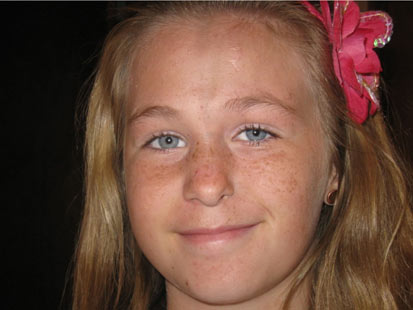Girl With Rare Facial Deterioration Saved by Surgery
Girl's deteriorating face saved by innovative surgery.
March 1, 2011— -- Christine Honeycutt's battle with a rare disease started about six years ago with something doctors and her mother thought was nothing more than a birthmark.
"I noticed a small line in her forehead. It looked like she ran into a door jamb," said Vicki Honeycutt, Christine's mother.
Doctors told Honeycutt not to worry too much. They gave her cream to put on it, instructed Christine, then only 5 years old, to stay out of the sun and said it would eventually fade away.
Over the years, despite doctors' reassurances, the line only got darker and deeper and one summer, after moving from North Carolina to southern California, Honeycutt noticed something else.
"One day, I kissed her ear and then she rolled over and her right ear was in my face. I noticed her left ear was half the size of her other ear, and also that her nostril on her left side looked like a baby's nostril," she said.
After a visit to another pediatrician, numerous tests and then a consultation with a genetic specialist the pediatrician recommended, Honeycutt had a diagnosis: Parry-Romberg Syndrome, a rare condition that progressively causes the skin and tissue of one side of the face to waste away. The degree of atrophy varies from person to person. No one knows what causes the disease and there is no cure.
Patients with Parry-Romberg may also have neurological symptoms, such as seizures and severe migraines. Honeycutt said Christine had a seizure when she was 7 and also suffered from severe pain in her face as well as bloody noses.
Even though the condition has no cure, that wasn't going to stop Honeycutt from trying to save Christine's precious face, despite the fact that numerous doctors told her there was no hope.
"There had to be something we could do," she said. "I was not going to sit here and watch my daughter's face cave in."
There have been case reports that methotrexate, a cancer drug, stopped Parry-Romberg's progression. But it didn't work for Christine, who has since moved back to North Carolina with her family.

Innovative Surgery Saves Christine's Face
After the unsuccessful treatment with methotrexate, Honeycutt found Dr. John Siebert, professor of surgery at the University of Wisconsin School of Medicine in Madison. Siebert has performed a special type of microsurgical reconstruction on about 120 people with Parry-Romberg Syndrome.
He operated on Christine on Nov. 15. The surgery involved taking tissue from the area under her arm near where her breast would be and transplanting it into her face. Siebert said the tissue already had working blood vessels.
Typically, he said, doctors let the disease completely run its course before performing reconstructive surgery. But he said that in many of his cases, including Christine's, he intervened early.
"Some parts of her face were fairly severe," Siebert said. "We don't know how severe she would have gotten if we waited."
A lot of reconstruction involves grafting a patient's own fat, he said, but in his experience, that hasn't always been very effective.
"I've operated on almost 400 people with facial deformities -- about 120 with Rombergs -- and of those 400, more than half had injected fat that failed and melted away," he said.
Other surgeons say since so little is known about Parry-Romberg Syndrome and there are so few patients identified, it's difficult to predict what the long-term effects of Siebert's microsurgical technique will be. But they believe it's very promising.
"It's a very unique and interesting new way to look at the disease and an innovative way to look at reconstruction," said Dr. Seth Thaller, professor and chief of the Division of Plastic and Reconstructive Surgery at the University of Miami School of Medicine. "What's different is the timing -- most people wait until they get older."
Thaller added that some surgeons are using a combination of fat and stem cells, and that this method and Siebert's use of tissue that already has functional blood vessels deserve a closer look to determine success over time.
After Surgery: So Far, So Good
Siebert said Christine's first surgery went well. She will have to have another surgery in the spring for what he calls "fine tuning." He'll remove some of the extra tissue that's caused some swelling.
One of the advantages of his microsurgical technique is the minimal side effects, he said.
"Other than the expense, the recovery from surgery and a scar at the donor site, there isn't much of a downside," Siebert said.
Methotrexate and certain steroids, both other possible treatments, can have very bad side effects.
According to Honeycutt, the surgery cost several thousand dollars, and some of the money was raised through a special foundation set up to help Christine and others like her.
So far, Honeycutt said, she and her daughter are pleased with the results, but there are still a lot of unknowns.
"This is not a cure, it's an intervention. I hope the disease won't progress or take away bone or her eyesight," Honeycutt said.
Having to endure a facial deformity and the symptoms that go with it as well as taunts from her peers taught Honeycutt's little girl a very adult lesson.
"It's given her compassion for other children," she said.